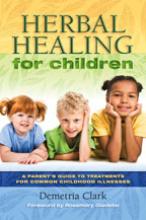HERBAL HEALING for CHILDREN

Many families are finding herbal medicines to be a safer, simpler, more natural way to care for their children. With fewer side effects than conventional medications, children often improve after just a few doses of herbal remedies—even when standard medicines have been ineffective. This easy-to-follow, practical guide to dealing with common childhood health issues empowers parents to take control of their children’s recovery from illness, and to give them safe and effective alternatives to potent medicines.
Along with finding easy teas for a tummy ache, drops for earaches, and treatments for eczema and diaper rash, they’ll learn about:
- commonly used herbs, why they work, and what conditions they treat
- how and where to buy or gather herbs, and how to preserve and store them
- how to make their own decoctions, herbal teas, infusions, and salves
- recipes for popular remedies, so they’re always available when needed
- which herbs to always have on hand and which can be dangerous for children
EXCERPT:
How to Dry Herbs Preserving fresh herbs guarantees that you’ll have a supply to carry you through the season. If you want to store your herbs for more than a few days, you can either dry them or freeze them. Air drying is the traditional method, oven drying and freezing are quicker, and microwave drying is handy for small batches. Remove all damaged, discolored, or diseased leaves before trying one of the following methods.
For medicinal uses, dried herbs are usually preferable to fresh ones, because they contain more concentrated amounts of the herb’s active ingredients. Dried herbs are easy to store and keep exceedingly well, so you’ll always have herbs readily available. There are many ways to dry herbs, from elaborate screening trays in a greenhouse to gas or electric ovens in an urban kitchen. The important thing to remember is that no matter how you dry herbs—whether you hang them from the barn rafters or zap them in your microwave—the point is to dry them, not cook them.
Most herbs can be dried, but there are exceptions. Garlic and stinging nettle should always be used fresh or frozen because their active compounds deteriorate when they are dried. Also, use freshly picked echinacea plants instead of dried. When drying whole branches or stems, strip off the flowers, smaller leaves, and very small stems. Wash the branches or stems under cool water and gently pat them dry with a dish towel or paper towel. Gather five to eight stems together and tie them into a bundle with twine or kitchen string. Place the bundle in a brown paper bag with the stems extending out of the open end and tie the bag closed around the stems. Hang the bag in a dark, warm place (70 to 80 degrees Fahrenheit). Depending on the temperature and humidity, drying time will take two to four weeks.
Demetria Clark is an internationally known herbalist and aromatherapist. She pioneered online herbal education, having taught over 1,000 students via distance learning as of 2006. She founded the Heart of Herbs School in 1998 which offers online certification courses in herbalism and aromatherapy. She teaches in the U.S. and Canada at herbal and international midwifery conferences.
Our Books | Contact Us | About BPC | Return Policy | Manuscript Submission
BPC, PO Box 99, Summertown TN, 38483
Orders: 888.260.8458 | Office: 931.964.3571 | FAX: 931.964.3518
info at bpc-pub.com

